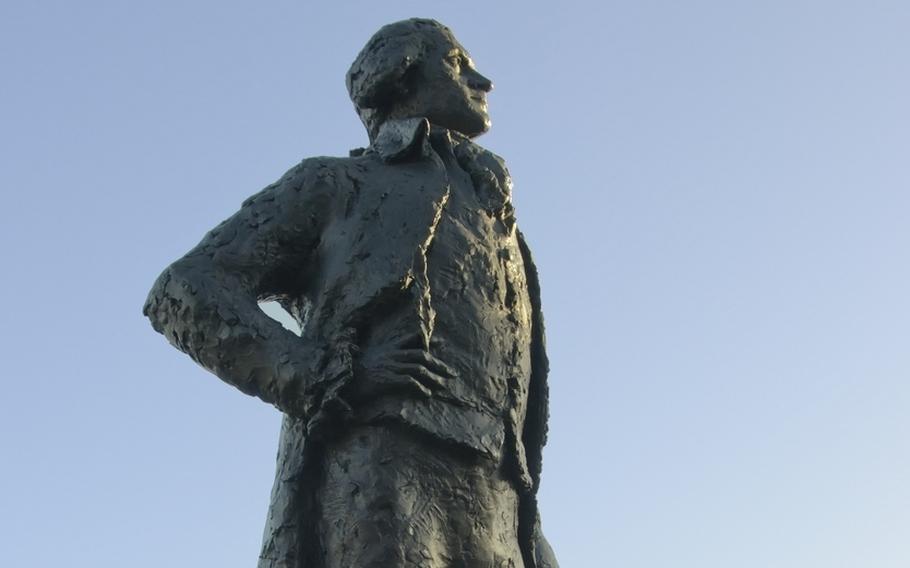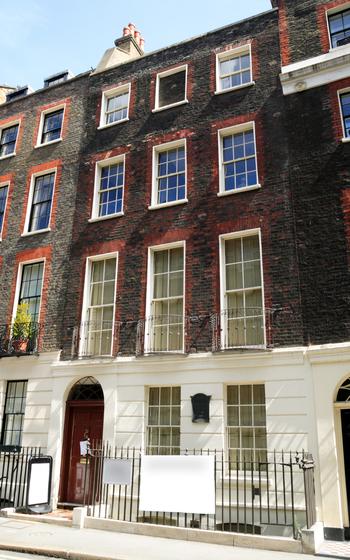
This statue of Thomas Jefferson was presented to France in 2006. It stands on Paris’ Left Bank, in the 7th arrondissement. (iStock)
Many events of great significance to U.S. (and indeed world) history and politics took place not within the country itself but on foreign soil, in large part due to the presence of some of our nation’s most beloved presidents and famous statesmen. In a trio of European capital cities, visitors eager to experience encounters with these legendary figures from our history books can explore these addresses both famous and obscure.
Paris
On Sept. 3, 1783, the Treaty of Paris was signed by U.S. and British representatives, thus ending the American War of Independence. The signing of this treaty by Benjamin Franklin, John Adams and John Jay on the American side took place at the no-longer-in-existence Hôtel d’York located at 56 Rue Jacob, in the city’s St. Germain district. On the corner of Rue Jacob and Rue des Saints-Péres, between a café and the Hotel du Danube, a plaque was installed to mark the spot. Online: tinyurl.com/3nccudjr
Franklin served as the modern-day equivalent of ambassador to France, and from 1777 to 1785, he resided in the Passy area in Paris’ 16th arrondissement. Much beloved by the French, a bronze statue of Franklin now overlooks the Square de Yorktown, so named for the battle that took place in Virginia in 1781. The bronze, a replica of a statue located in Philadelphia, was given to Paris by American banker John H. Harjes on the 200th anniversary of Franklin’s birth. The monument stands, fittingly, on the end of Rue Benjamin-Franklin, the name of the street since 1791. Franklin’s former home, the Valentois Mansion, is located at what is now 66 Rue Raynouard. Online: tinyurl.com/4buputdn
In 1785, Thomas Jefferson succeeded Franklin as first Minister to France, a role he held through 1789. On July 4, 2006, the Florence Gould Foundation, along with Alec and Guy Wildenstein, presented a statue of Jefferson, third president of the United States, to the city. The statue can be found on the Left Bank, in the 7th arrondissement, near Passerelle Léopold-Sédar-Senghor. The statue is also very close to the Palais de Salm, one of the buildings to have inspired Monticello, Jefferson’s home in Virginia. Online: tinyurl.com/yeypm5nw
George C. Marshall, appointed the Army’s chief-of-staff in 1939 and the first man to be promoted to the rank of five-star General of the Army during World War II, served as secretary of state to President Harry S. Truman from 1947 through 1949. It was in this role that he achieved one of his greatest victories, the implementation of the Marshall Plan. This plan, officially known as the European Recovery Program, was instrumental in helping allied European countries rebuild their economies and halt the proliferation of communism. In 1953, he was awarded the Nobel Peace Prize for his efforts. A plaque commemorating the 50th anniversary of the Marshall Plan’s signing can be seen on Hôtel de Talleyrand, on Rue de Rivoli, in the northeast corner of Place de la Concorde. The building served as the European headquarters of the Marshall Plan from 1948-1951 and later housed other U.S. government offices. The George C. Marshall Center, located on the second floor, serves as diplomatic receiving rooms and a venue for official events. Online: tinyurl.com/3bykhmsf

Benjamin Franklin lived at 36 Craven Street close to London’s Trafalgar Square for 16 years from 1757-75. (iStock)
London
The Ben Franklin House, located at 36 Craven Street in the heart of London, was opened to the public on Jan. 17, 2006, on the 300th anniversary of Franklin’s birth. The house, considered an architectural gem in its own right, shines a light on the nearly 16 years between 1757 and 1775 that Franklin spent at this address. Programs for visitors include a historical experience featuring costumed re-enactors, architectural tours and other events. Online: benjaminfranklinhouse.org
Berlin
On June 26, 1963, U.S. President John F. Kennedy delivered a speech to the citizens of Berlin from the square in front of the former City Hall of West Berlin, famously stating: “Ich bin ein Berliner.” On Nov. 25, 1963, three days after Kennedy’s assassination, the square in the Schöneberg section of Berlin was renamed John-F.-Kennedy-Platz in his honor. One year following his speech, a large plaque dedicated to Kennedy was affixed to the wall by the entrance to the former city hall. Online: tinyurl.com/5c946w87
Upon his visit to Berlin, Germany on June 12, 1987, U.S. President Ronald Reagan gave a speech commemorating the city’s 750th anniversary in front of the Brandenburg Gate, imploring General Secretary of the Communist Party of the Soviet Union Mikhail Gorbachev to tear down the Berlin Wall. On Nov. 9, 1989, destruction of the wall began, and on the eve of the 30th anniversary of this event, a statue of Reagan was unveiled. The larger-than-life bronze statue sits on the rooftop terrace of the U.S. Embassy, overlooking the Brandenburg Gate. The statue joins a memorial plaque to Reagan installed along the Strasse des 17. Juni in 2012. Online: de.usembassy.gov/reagan